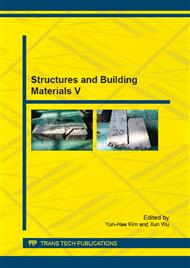p.13
p.18
p.23
p.27
p.34
p.38
p.42
p.48
p.52
Influence of Stiffness Weakening at Construction Joints on the Deflection of Cantilevering-Cast Prestressed Concrete Box Girder
Abstract:
For a long-span prestressed concrete box-girder bridge erected by the double-cantilever segmental method, concrete of segmental joints and concrete in their nearby area may be different from integrally-cast concrete in structural performances. For example, the stiffness of segmental joints could be weakened significantly. To reveal influences of weakening in the stiffness of segmental joints on the deflection at mid-span of box girder, a typical continuous rigid frame bridge in China was taken as the analysis example, and its finite element models were established. In these models, weakening joints were simulated. After the validity of finite element models were warranted, the deflection in the completed construction stage and the long-term deflection in the running period of box girder were calculated, and then the variation of these deflections with the stiffness reduction in all segmental joints was described. Results showed that, compared with the shearing stiffness reduction in segmental joints, the bending stiffness reduction played more significant role in affecting the deflection of box girder. When the weakening times of joint stiffness arrived at 100, deflection values of the box girder increased significantly. However, in the practical engineering, the determination of stiffness reduction in segmental joints according by their damages, and the incorporation of weakening segmental joints into the bearing capacity assessment for existing box girders were all worth further study.
Info:
Periodical:
Pages:
34-37
Citation:
Online since:
July 2015
Authors:
Keywords:
Price:
Сopyright:
© 2015 Trans Tech Publications Ltd. All Rights Reserved
Share:
Citation:


